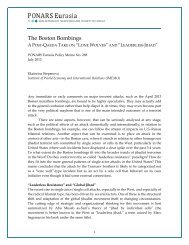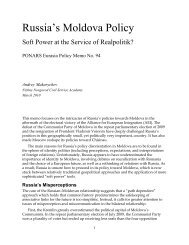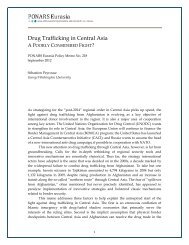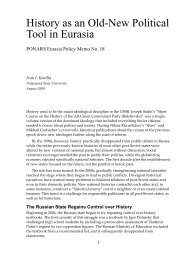HEMSHIN, HOMSHETSI, OR HEMSHINLI? - PONARS Eurasia
HEMSHIN, HOMSHETSI, OR HEMSHINLI? - PONARS Eurasia
HEMSHIN, HOMSHETSI, OR HEMSHINLI? - PONARS Eurasia
- No tags were found...
Create successful ePaper yourself
Turn your PDF publications into a flip-book with our unique Google optimized e-Paper software.
<strong>HEMSHIN</strong>, <strong>HOMSHETSI</strong>, <strong>OR</strong><strong>HEMSHIN</strong>LI?ARMENIAN SPEAKING MUSLIM PEOPLEOF THE BLACK SEA REGION<strong>PONARS</strong> <strong>Eurasia</strong> Policy Memo No. 53Nona ShahnazaryanKuban Social and Economic Institute, Center for Caucasian and Pontic Studies (Krasnodar)December 2008This memo is based primarily on field research material gathered in the areas ofHemshil settlements, including the villages of Vpered, Erik, Kim, Kalinin, andKubanskaya, all of which are in the Apsheronsk district, Krasnodar Territory, RussianFederation, and the villages of Sarpi, Akhalsopeli, Kakhaberi, Gonio, Dzharnali, Feriya,and Urekhi in the Khelvachauri district, Adjara, Georgia. The memo is about identitytransformation affected by social context and political background/pressure.Hemshils (they call themselves Homshetsi) are normally considered to be ArmenianspeakingTurks possessing what has been referred to as an “imprecise” or “migrating”ethnic identity. The majority of researchers believe that Hemshils are the descendants ofArmenians from the Hamshen region on the Eastern Anatolian coast of the Black Seawho were subjected to forced Islamization.Factors that Promote Marginalisation of the HemshilsThe Hemshils simultaneously bear more than one identity. Which factors can beconsidered to have influenced this process? Ethnic identity has frequently (one mightsay, cyclically) played a fateful role in the history of the Hemshils. National concepts,both among modern-day Hemshils and their forebearers, emerged from difficultpersonal experiences in contemporary cultures, in which national identities have led todisastrous situations that constitute a threat to physical existence. Complex turningpoints in the history of the Hemshils appear to have a direct correlation to the fact that1
one identity rather than another.A degree of marginalization is often reflected by informants. A Hemshil womanfrom Batumi complained that a jealous Muslim Hemshil in Kemal-Pasha was still calledZiya Gyavur (gyavur means faithless, an infidel). “We belong nowhere, that’s what is soawful. In Russia we are Muslims, in Turkey gyavurs.” Often it is precisely thesespontaneous reflexes, thinking aloud, that reveal the direct process of constructingethnic identity:“What is a homeland? Where you are born and grow up. But wedon’t have that. In this century we are migrants, from Turkey toBatumi, from Batumi to Kyrgyzstan, Central Asia, and here. Ahomeland is somewhere where people accept you, where theyknow you, respect you, value you. We don’t have that here. […]Already we can’t seek our past because our past is in differentplaces. Some say that our homeland is where we were born,let’s go there. Fine, but what about our children? They alreadyspeak a different language, they have been brought updifferently.”Thus, the formulation of Hemshil identity, the Hemshil ethnic code, is based on anall-embracing marginalization, the community’s exclusion from social networks in thehost culture. These divisions have a huge social significance at the micro-level. Peopleneed to be able to present themselves in society, and this influences what sort of nichethey can occupy in that society or whether they can occupy one at all. Formulating thiscode has a direct relation to real history, which is specifically constructed on “fate,”mobilizing collective identity on the principle that “if they don’t accept us in the newsociety we will create our own internal solidarity.” The result is a closed community. Inthis sense, the choice is predetermined. Social development in the host society is madeexceedingly difficult, while social life outside of one’s own community is almost nonexistent.Marking of a New MarginalizationThe ambiguous situation of the Hemshils of Krasnodar has driven the Hemshils toconfusion and misunderstandings with the local population and, especially, with localofficial structures that cannot distinguish who is who. In this multi-ethnic context, inwhich there is a multiplicity of self-identities, people find that they no longerunderstand who they are. The Hemshil leaders appear impotent and unable to make achoice that would bring their community, in the sociologist Pierre Bourdieu’s words,“the optimal economic, symbolic, and cultural capital.” They vacillate tortuously overtheir final choice and the legitimization of their ethnic status, which would providetheir community with stability and prosperity. Consequently, there has still been noindication of unified opinion among rank-and-file Hemshils. The scales tilt one momenttoward strengthening Turkish identity and uniting forces with the similarly “punished”Meskhetian Turks with the aim of survival, the next moment toward insistence uponthe unique nature of Hemshil cultural roots, and the next moment toward thereconstruction and the renaissance of a “lost” Armenian identity. However, they are4
extremely careful about adopting, much less institutionalizing, an Armenian identity. Itis possible that this is because, were they to adopt this identity, the Hemshil guiltcomplex of being potential traitors to the faith would increase. The stamp ofconfessional inconsistency and “disloyalty” would be added to the experience ofdeportation as “undesirables” and “enemies of the people.” Recognizing oneself asArmenian would mean accepting that one’s ancestors “betrayed” Christianity and,later, Soviet ideals. Moreover, a Christian past is hard to reconcile with the Islamicdiscourse that dominates their daily lives.Public Discourse and PhobiasThe Hemshils, as well as Meskhetian Turks, Kurds, and other ethnic groups inKrasnodar, are among the most disenfranchised population groups. They are excludedfrom refugee status and from the social protection mechanisms that derive from thisstatus, and they are also deprived of residency registration. The issue of residencyregistration and citizenship is pivotal. Resolving this issue would inevitably resolvemany of their other problems. However, Krasnodar authorities, true to an essentialistparadigm, unambiguously refuse to legalize deprived groups (including the Hemshils).Hemshils, like Meskhetian Turks and other ethnic groups, are considered by regionalofficials as a “destabilizing factor” based on ideological myths and spy-mania. Theregional governor and his supporters even threaten deportation camps that will be thebasis for “expelling migrants.”An infamous racist speech by the governor of Krasnodar, Alexander Tkachev,agitated local ethnic minorities, in particular Hemshils and Meskhetian Turks, becausethey bear the family names that end with the syllables pronounced as “outside the law.”Family names, in the context of contemporary public discourse, create a particularlyblatant marker of formal “ethnic” status. The spiritual leader of the Hemshils stated, “Iam changing my family name and dropping the ‘-ogly’. I went to the public recordsoffice and made an application to Kyrgyzstan on behalf of my children, I have alreadyreceived the response…” In daily interaction, one’s family name, external appearance,accent, and other markers give rise to and reinforce inequality. Changing one’s familyname means ridding oneself of the stigma, at least for locally-born children, who arealready impossible to identify based on differences in intonation and turns of phraseborrowed from a “household” language. Marginalization and a rich experience of socialinequality create a need to artificially correct one’s identity.Xenophobia and explosions of racism in public discourse have made the problem ofHemshil identity a contemporary one, forcing them to more clearly define their selfidentity.In 2002, the Hemshil leaders initiated a written request to the RussianAcademy of Sciences’ Institute of Ethnology and Anthropology for a historicalcertificate defining the status of their ethnic group:“We, the representatives of the Hemshil people (who callthemselves [K]homshetsi) are requesting that you assist us inobtaining a historical certificate which will confirm our ethnicorigin as a separate Hemshil nation. At the moment, for varioussubjective and objective reasons, our people are designated in a5
not yet at an end. This research vividly demonstrates the extreme flexibility of ethnicidentity, continually reacting to social change and particularly to social disruption thatthreatens disaster for the ethnic community. The research supports the theses of PeterBerger and Thomas Luckmann that “identity changes when for some reason it becomesa problem. …Radical changes in the social structure can be a factor when accompaniedby changes in the prevailing psychological reality.” It is precisely these processes thathave been at play and that continue to prevail in the case of the Hemshils.<strong>PONARS</strong> <strong>Eurasia</strong> publications are funded through the International Program ofCarnegie Corporation of New York. The views expressed in these publications are thoseof the author alone; publication does not imply endorsement by <strong>PONARS</strong> <strong>Eurasia</strong>,Georgetown University, or the Carnegie Corporation.© <strong>PONARS</strong> <strong>Eurasia</strong> 20087










